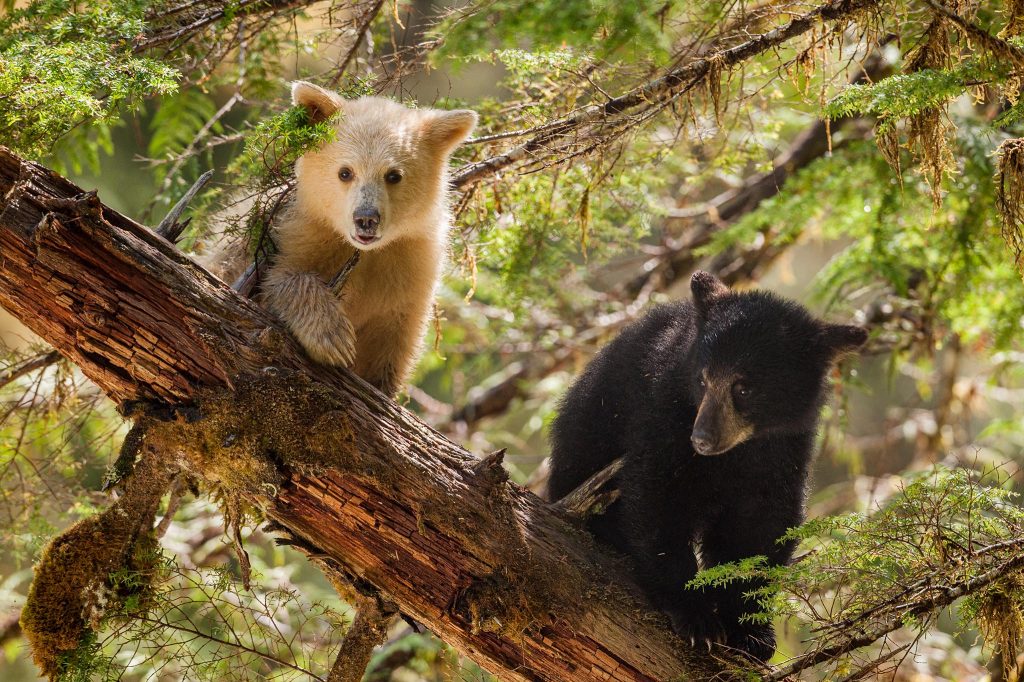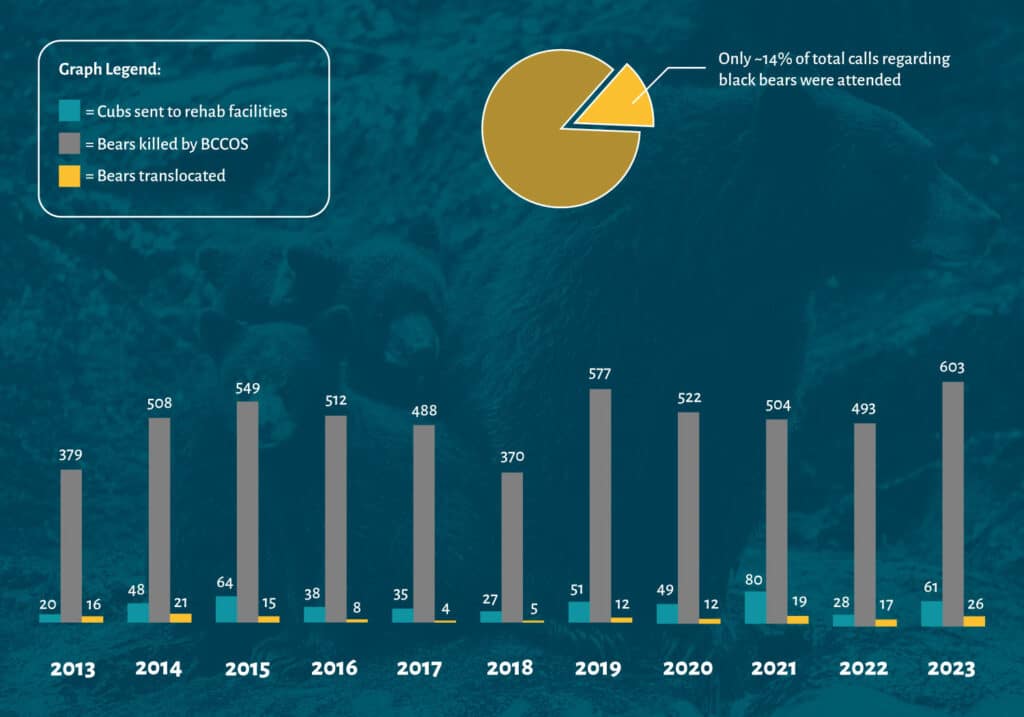In fall of 2022 in the community of Nelson, British Columbia residents were stricken with grief following the killing of a mother bear and her cub by the B.C. Conservation Officer Service (BCCOS). Residents were aware that a second cub belonging to the family had hidden in a tree as his mother and brother were shot. Community members can vividly recall hearing loud cries from the young cub for days afterward. As far as these residents are aware, no attempt was made by BCCOS to capture the second cub and deliver the young bear to any of the three available rehabilitation facilities in the province.
Despite the formidable odds against the surviving cub and to the community’s delightful surprise, the bear survived the winter of 2022 and was spotted several times throughout 2023 – even observed in a local park playing on a slide with another young bear. The young bear had been roaming the town for several weeks this winter causing concern due to apparent loss of fur in her longer outer coat. She also looked thinner than the average bear given the time of year- though experts claim she appeared relatively healthy. After a few day period with no sightings of this locally treasured bear, community members began to worry.
Regardless of the expert opinion on the bear’s overall condition, the young bear was tranquillised in a local resident’s backyard by the BCCOS. While under sedation she was evaluated by the conservation officer who communicated their observations to a biologist over the phone. Shortly after, the bear was killed by the officer on scene.
While it’s understood that only “cubs of the year” (meaning cubs first emerging from the den that year) are eligible for rehab, it stands to question why there was no attempt to help this bear the year before when it was recently orphaned. An effort as simple as catching that cub and bringing it to a rehab facility until she was old enough to be released and survive on her own could have saved her life.
A few weeks prior in Vancouver Island’s Comox Valley, another orphaned bear cub was spotted on the side of Highway 19. Upon first sighting, the cub appeared quite emaciated, which is unusual for the post-hyperphagia season. According to a veterinary expert, the cub would be a prime candidate for rehabilitation. Sadly, this opportunity was not afforded to the tiny cub as it was also shot by a conservation officer.

The B.C. Conservation Officer Service (BCCOS) website states that they “recognize that maintaining public trust and confidence in the communities it serves is essential”.
The RAPP (Report All Poachers and Polluters) line is set up to receive calls from the public regarding human/wildlife interactions. In the last year 27,356 calls exclusively pertaining to black bears were made to this line, only 2,435 of those calls were attended by conservation officers (these numbers do not include follow up calls). Despite those numbers, public distrust remains because of the high number of animals killed, causing many communities to take to social media, discouraging their neighbours from calling the RAPP line. Although more public education is needed to reinforce that “not every sighting is cause for concern”, regaining the public trust in the BCCOS is essential in order to ensure that calls that are made provide increased opportunity for proactive resolutions and relocation options, ultimately reducing the number of wildlife deaths in the province. Early reporting typically allows the opportunity to encourage a change in animal behaviour by providing residential wildlife education, gaining public compliance with attractant securement, promoting neutral interactions, and providing quicker intervention tools like hazing and relocation to avoid escalations in potential negative behaviours that could be perceived as threats to public safety.
Officers of the conservation service are typically required to complete the following training: the Canadian Firearms Safety Course, the B.C. Conservation Outdoor Recreation and Education course, and a natural resource law applied degree or diploma (equivalent combinations of education and experience may be considered).
Upon successful candidacy for employment, new officer recruits are required to spend 16 weeks training at the Western Conservation Law Enforcement Academy (WCLEA). As stated on the B.C. government website “the curriculum places heavy emphasis on field skills and legal studies, including classroom and practical instruction in the following areas: ATV operations, Cross cultural awareness, Emergency vehicle operations, Law enforcement ethics, Firearms (rifle, shotgun, pistol), Use of force options, Water safety, Investigations, Legal studies, MED A3/SVOP, Small and large group prop vessels, Swift water rescue and Human wildlife conflicts”.
We can’t speak to the educational background officers may have before applying to join the service, though all of the prerequisites for employment within the service as well as the training provided and required for successful candidates are heavily centred on law enforcement and hunting with limited education pertaining to species-specific biology, life cycles, behaviours, ecology that promotes peaceful coexistence.
conservation statistics on black bears from 2013-2023

Four years have passed since Pacific Wild first called for accountability within the BCCOS by requesting officers to wear body cameras. The COS lacks public third-party oversight and conservation officers are often working individually and in remote areas. Implementing the use of body cameras would allow for more transparency around officer actions and observations, will help to build public trust, and be useful tools to support difficult or controversial decisions that officers have made. Having an independent civilian board overseeing the BCCOS, like other policing bodies in B.C., would also increase accountability.
The BCCOS consistently advises that bear killings are predominantly a result of attractant management issues in local municipalities. There are a number of studies that support the fact that if the public took care to secure or remove attractants, (garbage, fruit trees, etc) , wildlife interactions would decrease in our communities, and hence the reactionary killings. However, another study shows that attractants are not the whole issue, and that a new approach is necessary.
Most predators are opportunists and will take advantage of easy and readily available food sources – it’s an energy vs. calorie expended trade for them. Wildlife are not able to distinguish between what we consider to be natural and non-natural food sources-they simply see food. Eliminating the opportunities for them to access non-natural foods reduces the potential for interactions that put wildlife in danger. However, even if every attractant was secured or eliminated, wildlife would still come into communities.
Encouraging neutral encounters in communities should be a priority in coexistence. Positive encounters would include animals finding a food source that may encourage them to stay or revisit the area. Negative encounters would include chasing and intimidating wildlife resulting in fearful and potentially defensive reactions. Neutral encounters would simply be that of coexistence, an animal passes through the community without trouble, the public goes about their day with the understanding that we are all sharing the landscape.
Coexistence is a complex matter and the onus should be on the Province to pursue proactive and non-lethal measures (localised bear education, relocation, enforce secure/removal of attractants, etc.). We want to see a culture shift that reflects a mandate to prioritise and understand animal wellbeing, not exclusively attenuate conflicts.
The provincial landscape has limited space that we all exist in, and as human development and industrial extraction continues to destroy more habitat, we have to expect to coexist with bears, we continue to build our own homes on top of homes that were once theirs. Coexistence is achievable, and we need to make use of every non-lethal avenue available to safeguard these animals from harm.
Please consider sending a copy of our pre-written letter to demand accountability and consideration toward our wild neighbours.

